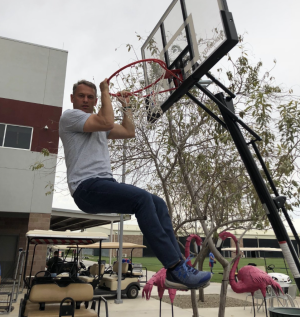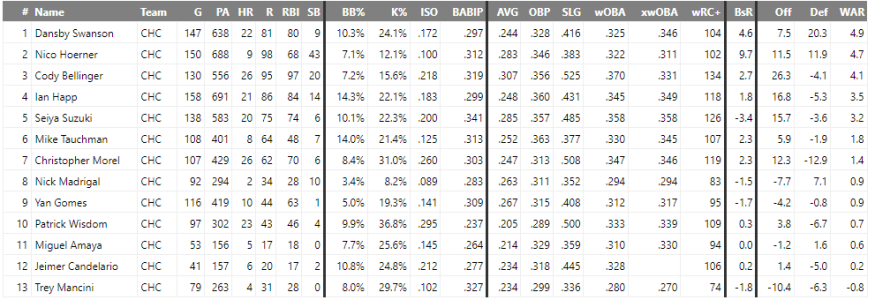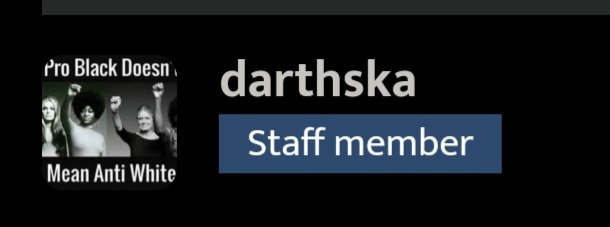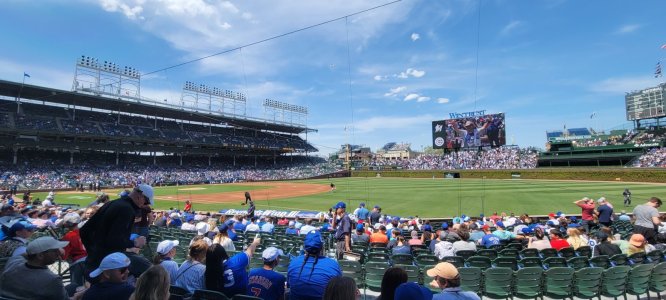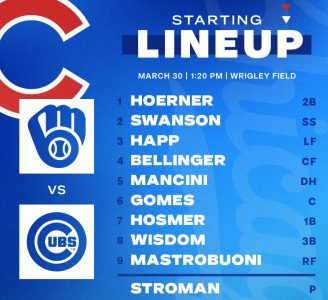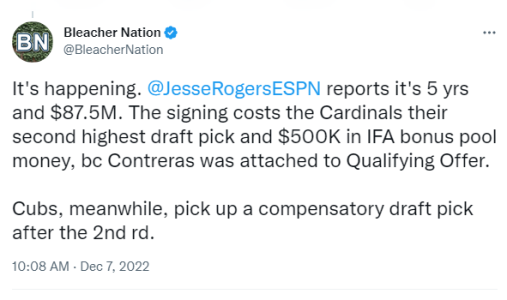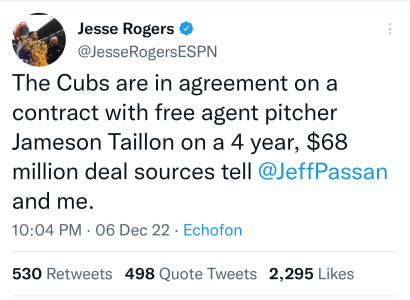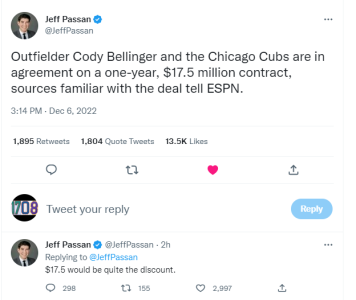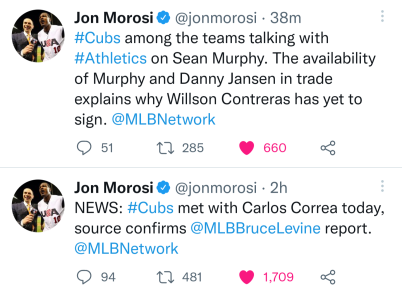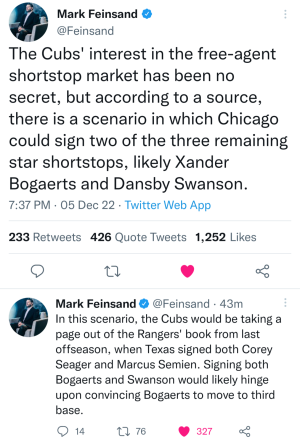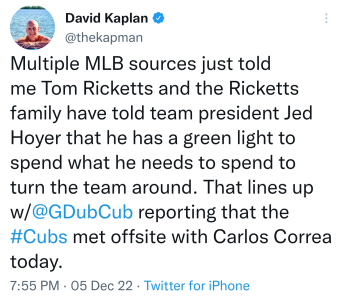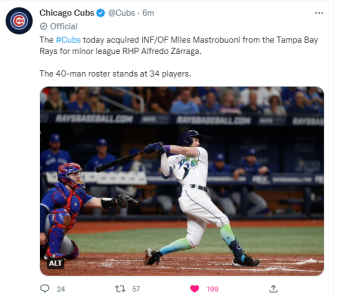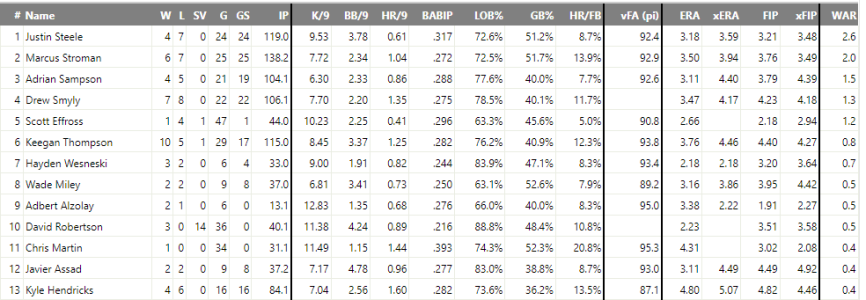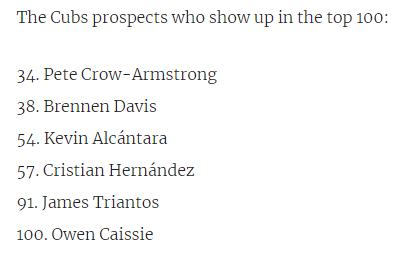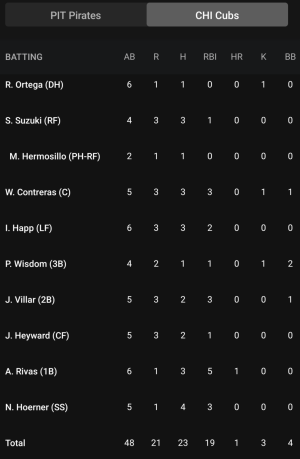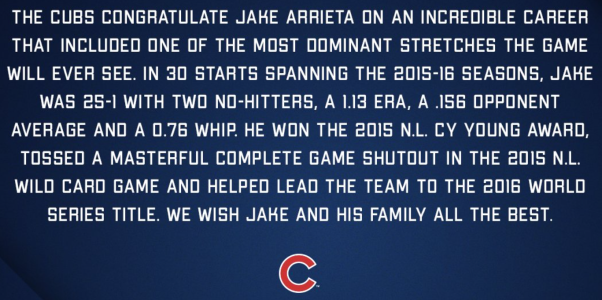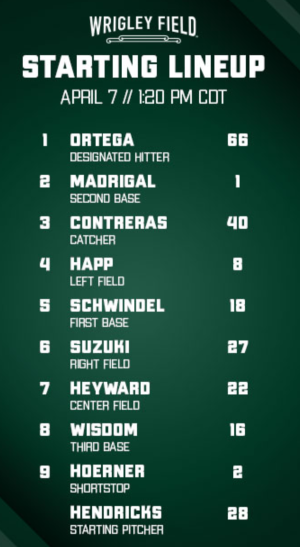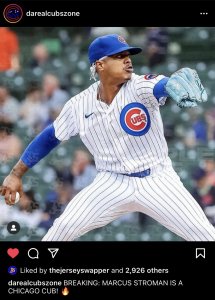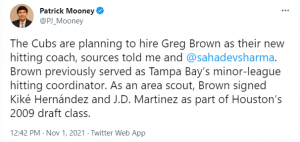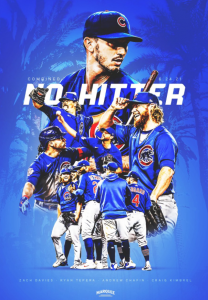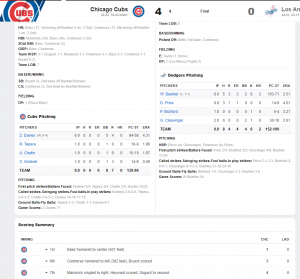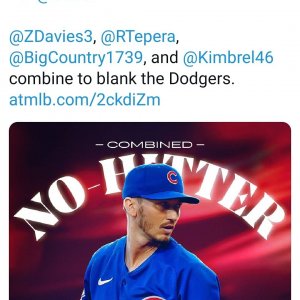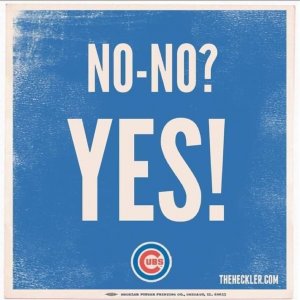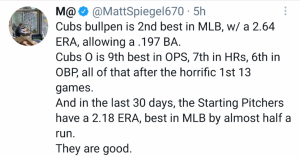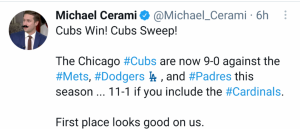Navigation
Install the app
How to install the app on iOS
Follow along with the video below to see how to install our site as a web app on your home screen.

Note: this_feature_currently_requires_accessing_site_using_safari
More options
You are using an out of date browser. It may not display this or other websites correctly.
You should upgrade or use an alternative browser.
You should upgrade or use an alternative browser.
Official 2023 Chicago Cubs Season Thread Vol: (17-17)
- Thread in 'Sports & Training' Thread starter Started by CP1708,
- Start date
- 1,887
- 503
- Joined
- Sep 7, 2011
I'm getting ready to update some info in the OP, but man, look at the very first post, and how things look now.
Going to add the Russell, Schwarber, Arrieta photos to the bottom of the first post, and some other stuff from the season as well. So we can kind of compare the status of where we were, and where we are now, and where we're headed in the offseason.
i think you should add McKinney as well.
Last edited:
- 1,887
- 503
- Joined
- Sep 7, 2011
This falls more in line with the approach Theo has always maintained. I said they could make a big push for Stanton, then sign Scherzer and Lester (a long shot, I know), but in terms of things Theo's said, he makes it sound like it would be 1 pitcher this off season, and then another one next year, ready to compete fully in 2016.
Either way, soooooooooon.
I would like to have Stanton,Price and Scherzer. It can happen.
arstyle27
Supporter
- 10,252
- 3,290
- Joined
- Nov 13, 2001
Going to Wrigley tonight. Excited to catch these young dudes in person.
Going to Wrigley tonight. Excited to catch these young dudes in person.
That's awesome man, enjoy. Where you sittin?
Not enjoying Rizzo and Starlin bein a little banged up, but it might help us a little, we need to start losin a couple extra games here pretty soon.

Need to stay within that top 10 of the draft to keep our pick for when we sign any free agents.
- 28,043
- 10,465
- Joined
- Jan 7, 2004
Missed my chance in mid-August. Gave away tickets to less fortunate folks.Going to Wrigley tonight. Excited to catch these young dudes in person.
- 28,043
- 10,465
- Joined
- Jan 7, 2004
Thank you, sir. Much appreciated.Champ, you're up in the Re-Draft.....

DES MOINES, IOWA -- Moments after watching Kris Bryant spray baseballs around and out of Principal Park during a recent batting practice session, Manny Ramirez shakes his head.
Ramirez, the 12-time All-Star, 2004 World Series MVP and currently player-coach for the Pacific Coast League's Iowa Cubs, has seen a sea of sluggers and thousands upon thousands of swings.
The still-blossoming Bryant, at age 22, has the potential to be the best of the bunch. "He's unbelievable," Ramirez says.
Bryant anchors the newest generation of big-swing, short-memory hitters in baseball. The booming bat is the reason the Chicago Cubs invested their largest signing bonus in history — nearly $6.71 million in 2013 — and the reason he has been selected as the 2014 USA TODAY Sports Minor League Player of the Year.
Ramirez, when asked what makes Bryant exceptional, chuckles.
"He's 6-5, bro," he says. "He stays inside on his swing all the time. He's so tall that when he misses a ball, he can still hit it out. The thing I like about him, he knows how to turn the page. If he misses an at-bat, he forgets about it and moves on to the next one.
"A lot of players can't do it, but he knows how to do it at such a young age."
On the upswing
The statistics produced by Bryant's unique plate approach reinforce his ability to affect games and damage the ERAs of opposing pitchers.
With Iowa's season complete, Bryant led the minor leagues with 43 homers, while recording 110 RBI and a .325 average between Classes AAA and AA.
Bryant's father, Mike, spent two seasons in the 1980s in the Boston Red Sox organization — soaking up hitting tips from Hall of Fame slugger Ted Williams. Those discussions fueled a swing discipline Mike and Kris have worked on since the current sensation was 8.
The goal of each Bryant at-bat: Swing up and swing decisively — and the rest will take care of itself.
"Ted Williams used to say, 'If I hit it hard and hit it in the air, I'm going to be all right,'" the elder Bryant says. "That was his whole philosophy, that slightly upward swing while everybody else was swinging on a downward path, trying to put backspin on it to lift the ball into the air.
"Ted Williams figured out the launch angle. When you've got a guy who's 50 years ahead of the curve in terms of hitting, you're sitting there listening and you feel like you're learning calculus or aeronautical engineering or something. It's the science of hitting."
Mike Bryant remembers the ball-smashing milestones: Kris hit his first homer during a practice as an 8-year-old. At age 9, he homered seven times in a seven-game tournament in St. George, Utah. As the swing gained polish, Mike Bryant preached sabermetrics — quoting websites about the high percentage of ground-ball outs.
The training then shifted to mental resolve, specifically the ability to move on from lost moments at the plate.
"The talent gets you so far. But if you're more mentally strong at the plate, you're less likely to give away an at-bat or a pitch," says Kris Bryant, a third baseman. "If you dwell on things, you can miss a pretty good pitch to hit. Over the course of the year, that can add up to quite a few at-bats."
Potential distractions for Bryant also come in the form of expectations in Chicago, where the Cubs are mapping a future that includes Bryant, shortstop Javier Baez and outfielders Jorge Soler and Albert Almora.
"Is there pressure?" Mike Bryant says when asked. "What I tell him all the time, the pressure exists on the outside. It's a demon. If you allow that into your head, it'll wreak havoc like a gremlin destroying your house — your mental house."
Bryant has mastered short-term thinking from the moment he was promoted from Class AA (Kodak) Tennessee to Iowa this season. He played 68 games with Tennessee.
His first five Class AAA hits were homers, a record for that level. Bryant struck out nine times in those initial 21 at-bats, but he maintained the confidence to stick with his plate protocol.
An example: On Aug. 14, Bryant hit a two-run, walk-off home run in the 12th inning for Iowa — after going 0-for-4 with three strikeouts before homering.
The game-ender was Bryant's 40th minor league home run of the season as he became the second player to reach that mark in the last five seasons. The other was Las Vegas friend and Mike Bryant-trained slugger Joey Gallo, the Texas Rangers' top prospect and runner-up in voting for this year's USA TODAY Sports honors.
Bryant is fully aware of the edge-of-their-bleacher seats expectations in Chicago — and is shying away from none of it.
"Oh yeah, I know," Bryant says. "I flew into Chicago for the Cubs convention last year. It was crazy to see how people were waiting for you in the airport or waiting in the hotel lobby. They're so loyal to their team.
"When I went out there to sign, I got to witness it first hand — the passionate fan base, the blue shirts everywhere. It's something every ballplayer should want to be a part of. If that day comes for me, it will be the happiest day of my life."
If the hopes and dreams along the western shore of Lake Michigan seem sky-high, they fail to reach the level of the person stoking them.
"I can assure you my expectations are bigger than anyone else out there," he says.
'He can be Miguel Cabrera'
Time away from baseball is rare for Bryant, who enjoys golf — "I don't hit it very straight, but I hit it pretty far" — and has spent the last year and a half learning to navigate the guitar.
"I dabble around and type in 'learn how to play' for certain songs on YouTube," he says. "I focus on country. I like Jason Aldean, and Taylor Swift is fairly easy to play."
The activity is far from the most valuable use of Bryant's hands, which already are valued in the millions when wrapped around a bat.
If there is one criticism about Bryant, it's that he strikes out too much. He ended his season with the 12th-most strikeouts (162) in the minor leagues, while his friend and rising star Gallo sat fourth.
Jason McLeod, the Chicago Cubs' senior vice president for scouting and player development, says Bryant's strikeouts must be considered in context.
"We understand that strikeouts are going to be a part of Kris' game," McLeod says. "We always look at how he and all of our hitters arrive at those strikeouts. Is it the approach, swing mechanics, pitch recognition? Because his approach often has him seeing a lot of pitches and working deeper into counts, the walks and strikeouts are going to be a byproduct.
"His ability to get on base, hit for power and maintain a healthy OPS (on-base-plus-slugging percentage) to this point in his career lessen the worry somewhat with the high strikeout rate.
"That being said, Kris understands it's a game of adjustments and that he'll have to continue to make those adjustments upon his eventual arrival in the major leagues."
When asked how good his son can be, Mike Bryant pauses — but only briefly.
"He can be Miguel Cabrera," Bryant says of the Detroit Tigers' Triple Crown winner who is a career .320 hitter with an average of 35 home runs based on a 162-game schedule. "Cabrera, only with more speed and a better arm. Do I sound too much like a dad?"
The elder Bryant isn't the only one doing the name-dropping in reference to his talented son.
Ramirez, who hit 555 homers during his big-league career, says Bryant's ability to punish baseballs reminds him of 6-5 Hall of Famer Frank Thomas and 6-6 Miami Marlins slugger Giancarlo Stanton, who was second in the majors in RBI and was tied for second in homers as of Sunday.
"Two months ago, I saw Stanton get beat with a fastball, and he still hit it out to right field," Ramirez says. "I remember playing Frank Thomas. Sometimes he'd get in front with one hand and still hit it out.
"(Bryant) is like that."
***
The USA TODAY Sports Minor League Player of the Year was selected through voting on a pool of our finalists by USA TODAY Sports writers and editors plus readers at USATODAY.com. Each staffer's vote counted for one point. The winner of the online poll (Kris Bryant) received two points.
The vote breakdown:
3B Kris Bryant, Cubs: 9 points
3B Joey Gallo, Rangers: 2 points
RHP Tyler Glasnow, Pirates: 0 points
1B Matt Olson, Athletics: 0 points
LHP Henry Owens, Red Sox: 0 points
Sounding like Rizzo may be shut down for the rest of the year. Which is completely fine with me. Let him rest, he obviously had a great year, just get all the way healthy and be ready to make a run at it next year. (plus, if it helps us lose an extra game or two, all the better for what we need)
- 864
- 332
- Joined
- Apr 9, 2014
They were talking about that on The Score this morning. I agree, let him rest.
Last edited:
Lake Shore Drive
formerly slp product
- 7,336
- 2,445
- Joined
- Feb 8, 2005
Enjoy the game AR!
Make sure you pound a few old style's for the rest of us.
As much as I enjoyed ripping the Brewers playoffs hopes apart, we really need to start losing some games here.
Make sure you pound a few old style's for the rest of us.
As much as I enjoyed ripping the Brewers playoffs hopes apart, we really need to start losing some games here.
As much fun as we were having, some "sort of" sad news. With Rizzo possibly done for the season, Castro now may join him. |I
High ankle sprain for Starlin, and they may not want to take any chances (with either of them) and could shut them both down.
As I've been saying, the Cubs need to lose a few more games still to protect their top 10 pick, and keep the ability to sign any Free Agents. Plus, both Rizzo and Starlin had really really good years this year, so it makes sense to give them the extra rest. Get them 100% for what we all hope is a real big year next year.
In slightly better news, Kyle Hendricks won Rookie of the Month for August, and Soler could make a run at that award for September I suppose.
High ankle sprain for Starlin, and they may not want to take any chances (with either of them) and could shut them both down.
As I've been saying, the Cubs need to lose a few more games still to protect their top 10 pick, and keep the ability to sign any Free Agents. Plus, both Rizzo and Starlin had really really good years this year, so it makes sense to give them the extra rest. Get them 100% for what we all hope is a real big year next year.
In slightly better news, Kyle Hendricks won Rookie of the Month for August, and Soler could make a run at that award for September I suppose.

arstyle27
Supporter
- 10,252
- 3,290
- Joined
- Nov 13, 2001
Enjoy the game AR!
Make sure you pound a few old style's for the rest of us.
As much as I enjoyed ripping the Brewers playoffs hopes apart, we really need to start losing some games here.
Budweisers and 312 my dude lol
- 864
- 332
- Joined
- Apr 9, 2014
Good little article here:
http://deadspin.com/jorge-soler-is-here-and-you-should-pay-attention-to-th-1630556210
http://deadspin.com/jorge-soler-is-here-and-you-should-pay-attention-to-th-1630556210
Sparks of enthusiasm are once again kindling among Chicago Cubs’ loyalists, as the long-awaited influx of position-player talent onto their major league roster has begun in earnest. The club is far from a finished product, and a loaded minor league system is no guarantee of major league success — just ask some of the teams I’ll discuss below. It’s an exciting time on the North Side, however, and this is before Kris Bryant — arguably the best of the lot — has been penciled into the big-league lineup. How does this group match up with some other recent talent infusions?
For much of the 2014 season, the National League Central has featured one of the most interesting races in baseball. Until recently, it was a four-team scrum, and with the recent fade of the Reds, it’s now down to three. The one club that hasn’t been involved in anything more than a spoiler role has been the Chicago Cubs. They’ve arguably had more impact to this point on the AL West race, as they traded top starters Jeff Samardzija and Jason Hammel to Oakland back in July. In the process, they added to their stockpile of impact offensive talent, bringing the A’s two best position player prospects — shortstop Addison Russell and outfielder Billy Mckinney — into the fold. The club already had impact youth in place all season at the major league level in the person of Anthony Rizzo, and he has been joined by second baseman Javier Baez, outfielder Jorge Soler and utilityman Arismendy Alcantara as the summer progressed. Bryant, likely the best of them all, isn’t here quite yet, and 2014 first rounder Kyle Schwarber has torn the cover off of the ball in his pro debut. It is an embarrassment of offensive riches that Cubs’ fans hope can at long last lead them to the promised land.
Since 1993, I have compiled a season-ending ordered list of top minor league position player prospects based on both production and age relative to the level of competition. It doesn’t adjust for other types of context, such as ballpark or position, so it serves as more of a follow list than a true top prospect list. Still, with over 20 years in the bank, it is a good resource to look back and search for the closest matches to the Cubs’ current situation. To finish in the top 20 on my annual minor league position player list is a pretty big deal – they obviously don’t all pan out, but virtually every impact offensive player over the last 20 years has ranked that high at least once. This current Cubs’ group? Well, Bryant ranks #2 in 2014 (behind the Rangers’ Joey Gallo) and Rizzo and Baez both peaked at #4. Schwarber (#9), McKinney (#12), Soler (#14) and Russell (#20) all ranked in the Top 20 this season. Alcantara’s peak rank was #52 in 2013 — a pretty solid performance for a middle infielder, considering the lack of adjustment for positional context. Perhaps the most impressive aspect of all of this is that most of these guys are either in the major leagues or are very close to major league ready. They aren’t likely to be low-level flukes who will be exposed at upper levels.
I took a look back over my lists going back to 1993 and identified the 12 best clusters of top prospects who achieved a peak minor league position player ranking of 20 or better (with the odd “just missed” guy thrown in). They appear below.
ORG YRS PROS #1 PEAK RK PROS #2 PEAK RK PROS #3 PEAK RK PROS #4 PEAK RK
CLE 93 Thome 2 M.Ramirez 3 Giles 28
MIL 03-05 Fielder 2 Hardy 4 Braun 8 Weeks 10
MIN 01-03 Morneau 3 Mauer 11 Cuddyer 17
LAD 96-97 Beltre 1 Konerko 4 K.Garcia 12
TOR 94 S.Green 4 C.Delgado 6
ATL 08-09 Heyward 1 Freeman 5
CLE 02-03 Sizemore 2 V.Martinez 12 Crisp 16
KC 94-95 Sweeney 7 Damon 10
TB 05-06 BJ Upton 1 D.Young 1 Longoria 6 Dukes 18
MIA 08-10 Stanton 1 Dominguez 10 Morrison 13
KC 10-12 Myers 1 Moustakas 4 Hosmer 7
KC 06 Butler 15 Gordon 16
From bottom to top, here’s a thumbnail sketch of those systems, and the eventual major league impact of those players.
Three of the top 12 offensive prospect clusters belong to the Kansas City Royals, and two of them are in the process of writing some of the most important chapters of their careers. The 2006 group features Billy Butler and Alex Gordon. Neither qualifies as a superstar – though Gordon isn’t terribly far off. This is the only group listed that lacks a Top 10 minor league peak ranking.
The 2010-2012 Royals cluster was busted up by the trade that sent Wil Myers to Tampa for James Shields. Moustakas’ career is in some degree of trouble, but Myers and Eric Hosmer project as core players going forward for their respective clubs. The 2008-2010 Marlins “cluster” is basically Giancarlo Stanton and a couple lesser lights who just happened to earn Top 20 minor league rankings in the same time frame. When all is said and done, Stanton could well challenge for the title of best player on this list – pretty heady stuff, as there are some future Hall of Famers present. The 2005-2006 Rays group possibly presents a cautionary tale for the current Cubs. Upton and Young, though they have had somewhat productive careers, were expected to be much better, leaving only Longoria as a long-term stud among the group. The Cubs certainly hope none of their prospects becomes Elijah Dukes.
The highest-ranking Royals cluster is the 1994-95 Mike Sweeney/Johnny Damon collaboration. Sweeney was a catcher for a portion of his minor league career, and put up great numbers in a very pitcher-friendly environment at High-A Wilmington at one point. If I used some journalistic license to shoehorn in Carlos Beltran (#8 in 199, they would rank even higher.
The 2002-2003 Indians group features one homegrown player (Victor Martinez) and two shrewd trade acquisitions. Sizemore came over in the famous Bartolo Colon rental deal that represented the death knell for the Montreal Expos’ franchise, and Coco Crisp arrived from St. Louis as a player to be named later for a rental of Chuck Finley. Brandon Phillips had a couple of near Top 20 finishes as a member of the Expos organization, but performed poorly in the Indians’ minor leagues.
The book is still being written on the Braves tandem of Jason Heyward and Freddie Freeman, but it’s going to be a good one. Heyward’s offensive game has perhaps stagnated, but he remains a strong all-around player, and Freeman is one of the game’s most dependable sluggers.
Back in the day, the Blue Jays were one of the game’s most prolific drafting/Latin American scouting/player development machines. The Shawn Green/Carlos Delgado 1994 group represented the final salvo for a club that had won the previous two World Series championships.
Many forget that not only was Paul Konerko drafted by the Dodgers, he was also drafted as a catcher. He and Adrian Beltre were a fearsome 1-2 punch for the Dodgers in the 1996-1997 time frame, and at times, Karim Garcia appeared to be in their class as well. The power-before-hit Garcia never did learn to make contact at the major league level, though he was a useful role player for a few years.
The 2001-2003 Twins cluster laid the framework for one of the best small-market clubs of the past decade. Justin Morneau, Joe Mauer and Michael Cuddyer were the faces of the franchise for a decade, and only a post-prime, first base version of Mauer remains in place in Minnesota.
Ryan Braun is all that remains of the 2003-2005 Brewers cluster. While Corey Hart was the first to arrive in the majors – his peak rank was #27 – the group that also included Prince Fielder, J.J. Hardy and Rickie Weeks revitalized baseball in Milwaukee. I was present for some very quiet nights at Miller Park in the early 2000′s that won’t be repeated anytime soon thanks to this group.
It’s pretty tough to argue with the 1993 Indians for the best position-player-prospect cluster over this time frame. A couple of pretty much sure-fire Hall of Famers in Jim Thome and Manny Ramirez, and one of the most underrated players of his or any era in Brian Giles.
There is one thing that all 12 of these organizations and their prospect clusters have in common – none of them have won a World Series. The Indians came within a game of doing so, and the Rays’ group also went to the World Series. A few others have reached the postseason, with only middling success on the whole. A handful of the players listed went on to win World Series rings – Ramirez, Damon and Konerko – but only after leaving for greener pastures. These players were largely developed by small- to middle-market clubs, but had to go to large-market teams to win the big one.
Besides the Cubs, there are five other current prospect/young major leaguer clusters that could join the above list. From bottom to top, they are:
6. 2012-2013 Red Sox – Mookie Betts (#4 -2014), Xander Bogaerts (#8 – 2013), Garin Cecchini (#16 – 2013), Jackie Bradley Jr. (#17 – 2012)
This group has been hurt a bit by Bogaerts’ and Bradley’s big league struggles this season, but they aren’t the first top prospects to struggle in their maiden voyage. Bogaerts and Betts in particular retain very high upsides.
5. 2012-2014 Twins – Miguel Sano (#1 -2013), Byron Buxton (#2 – 2012), Oswaldo Arcia (#3 – 2013)
Just a year ago, an article could have been written about these three – the first trio from the same organization to occupy the top three slots in my annual list. Sano had Tommy John surgery, Buxton didn’t play much and Arcia has been a solid but unspectacular big leaguer. Their cumulative upside remains high.
4. 2011-2014 Rangers – Joey Gallo (#1 – 2014), Rougned Odor (#5 – 2013), Lewis Brinson (#10 – 2014), Jurickson Profar (#10 – 2012)
Gallo’s domination of the High-A Carolina League this season was virtually unprecedented, and along with the 20-year-old Odor’s representative major league performance, it made Profar’s second consecutive injury-plagued season more easily endured. Brinson’s a high-risk, high-reward type who is a ways away.
3. 2013-14 Dodgers – Joc Pederson (#6 – 2014), Corey Seager (#7 – 2014), Yasiel Puig (#15 – 2013)
Puig’s already a star, and Pederson and Seager are relatively low-risk types who should at least be quality major league regulars. Though the Dodgers are playing for the present, they have wisely drawn the line and avoided dealing their top two offensive prospects to bolster their 2014 club.
2. 2010-2014 Astros – Carlos Correa (#7 – 2013), Jon Singleton (#8 – 2010), Jose Altuve (#9 – 2011), George Springer (#11 – 2013), Domingo Santana (#20 – 2013)
The Astros stand out because of the volume of prospects. Even beyond this group, the Astros have waves of potential major league regulars and contributors in place – keeping all of them protected on their 40-man roster might be their greatest challenge. They haven’t proven as much at the major league level as some of the other current prospect clusters, but they will.
1. 2012-2014 Cubs – Kris Bryant (#2 – 2014), Javier Baez (#4 – 2013), Anthony Rizzo (#4 – 2012), Kyle Schwarber (#9 – 2014), Billy McKinney (#12 – 2014), Jorge Soler (#14 – 2014), Addison Russell (#20 – 2014)
They’ve drafted them (Bryant, Baez, Schwarber), signed them internationally (Soler), traded for them as major leaguers (Rizzo) and traded for them as minor leaguers (McKinney, Russell). The last few years haven’t been pleasant, but the Cubs are now poised to reap the benefits of the long-term plan put in place when Theo Epstein and Jed Hoyer took over.
The Cubs’ true test will be avoiding the fate of all of the other “prospect cluster” clubs discussed in this article. None of them were able to win the big one in October. While their century-plus championship drought is daunting, the club does possess the resources to keep premium talents in town for the long haul, unlike the smaller market clubs discussed above. Step one was to develop a talent procurement and player development machine. Done. Step two, have those players translate their tools and skills into major league performance. That is easier said than done, but the odds appear to be in the Cubs’ favor, given some patience (nods head toward Javier Baez). The ride should be fun, and could well end in the greatest party in the history of the Second City.
Good read. But also doesn't include Starlin, Almora, or the pitching they've assembled. In other words, even more riches than what their other examples had. And with Theo able to add pitching this year, and next, and possibly another top 10 pick in June, there's even more help on the way.

Great read on Kris Bryant who was named as the Minor League Player of the Year. 
http://www.baseballamerica.com/mino...e-player-year/?sm_id=social_20140909_31277456
I wanted to copy and paste it, but there are some pics and charts in the article that wouldn't format in here. So just click the link and you can read about him. Dude is going to be a stud.

http://www.baseballamerica.com/mino...e-player-year/?sm_id=social_20140909_31277456
I wanted to copy and paste it, but there are some pics and charts in the article that wouldn't format in here. So just click the link and you can read about him. Dude is going to be a stud.
- 1,887
- 503
- Joined
- Sep 7, 2011
Congrats to Kris bryant. Minor League Player Of The Year.
Lake Shore Drive
formerly slp product
- 7,336
- 2,445
- Joined
- Feb 8, 2005
Congrats to Kris Bryant 
Looking forward to watching him play live next year.
18 games left

Looking forward to watching him play live next year.
18 games left

After these 18 games, I will convert the title of this to Offseason thread, but I will keep it all in here. Reason being, we have a TON of info stored in here, and it will help show all of us who have been here the whole time, for when "new" fans will start appearing within a year or two. 
Once the new season starts, I'll update it all again, and have it ready for the 2015 season, complete with transactions, new players, etc.
This thread is going to be in a year or two.
in a year or two.

Once the new season starts, I'll update it all again, and have it ready for the 2015 season, complete with transactions, new players, etc.
This thread is going to be
 in a year or two.
in a year or two.Lake Shore Drive
formerly slp product
- 7,336
- 2,445
- Joined
- Feb 8, 2005
^

Can't rep you enough for this!
With the NL central thread gone, we needed a home.

Can't rep you enough for this!
With the NL central thread gone, we needed a home.
Man, even if we had the NL Central thread still goin, I was makin this a separate one. I wanted to be in here showing Theo's plan from jump. I could see it taking shape and how it would all unfold, hell, you can read page 1 in here, and you see almost detail by detail what went down months ahead of time. (only the names are different, like Bryant callup vs Soler callup, etc) Shark trade for pitching, only it turned out to be Shark traded for hitting. Which was fine too, bein Addison was a top 3 Minor League Player coming into the season.
I wanted this to be all on it's own, so we could follow the Minor League guys, call ups, pitching additions, trade rumors, etc, without NL Central clutter.
And I plan on keepin it goin during the off season and the new season next year. Someday, we'll go back and look at the start of this year and see how it all unfolded for us.
I wanted this to be all on it's own, so we could follow the Minor League guys, call ups, pitching additions, trade rumors, etc, without NL Central clutter.
And I plan on keepin it goin during the off season and the new season next year. Someday, we'll go back and look at the start of this year and see how it all unfolded for us.

Bruce Levine
@MLBBruceLevine
Cubs have Pro scouting director watching Jon Lester pitch . Not that the front office needs too know much about the pitcher

Still a chance we need to add an OF bat to the roster, in case it takes a while for Almora/McKinney/Schwarber to make it to the big league club. (Or if Schwarber sticks at C)
Well, there could be a new prospect on the way. 23 year old Cuban defector Yasmani Tomas could be the next player to sign with a big league club.
The Cubs will have the money of course, just a matter of who else makes a play for him (Yankees) and if he'd be open to signing with us. If Theo can get him, and grab Lester, and still have our top 8ish pick in June, somehow, we get an even bigger upgrade to our overall talent pool. Which is just ridiculous.
I'm going to build a statue of Theo on my front lawn if this keeps up.
Well, there could be a new prospect on the way. 23 year old Cuban defector Yasmani Tomas could be the next player to sign with a big league club.
Tomas put up huge numbers as a 21-year-old at Cuba’s highest level (.301/.340/.580) and again as a 22-year-old (.289/.364/.53before stepping back a bit this year (.290/.346/.450), which may have been related to an arm injury (and/or changes in league rules, which seemed to have brought down offense overall).
What Tomas really brings is huge power – Badler calls him a 70 on the 20-80 scale, which is excellent – and the ability to play all over the outfield. He’s most likely to be a corner outfielder, but the ability to technically play center suggests a nice bit of athleticism (even if he winds up in a corner).
The Cubs will have the money of course, just a matter of who else makes a play for him (Yankees) and if he'd be open to signing with us. If Theo can get him, and grab Lester, and still have our top 8ish pick in June, somehow, we get an even bigger upgrade to our overall talent pool. Which is just ridiculous.

I'm going to build a statue of Theo on my front lawn if this keeps up.

Lake Shore Drive
formerly slp product
- 7,336
- 2,445
- Joined
- Feb 8, 2005
Lester on Theo & Co.

I like Lester, but part of me really wanted Scherzer. I just don't think the Cubs are willing to pay the price. He turned down 140 mill extension from the Tigers......I can't see him taking less or us offering more.



View media item 1174965
"They [Cubs brass] always treated me with the utmost respect and class," Lester said earlier this season. "I have nothing but good things to say about them."

I like Lester, but part of me really wanted Scherzer. I just don't think the Cubs are willing to pay the price. He turned down 140 mill extension from the Tigers......I can't see him taking less or us offering more.
I'm going to build a statue of Theo on my front lawn if this keeps up.



View media item 1174965
Last edited:

